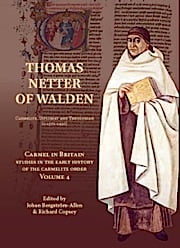 A new collection of essays and bibliography has been published about Thomas Netter in Thomas Netter of Walden: Carmelite, Diplomant, and Theologian (c. 1372-1430), ed. Johan Bergström-Allen and Richard Copsey (Faversham, Kent: St. Albert’s Press, 2009). Netter was a Carmelite (or Whitefriar). At Oxford, sometime around 1400, he was a student of the Franciscan William Woodford, an opponent of Wyclif who had earlier, apparently, been Wyclif’s good friend. Netter was present at several church councils and at various prosecutions by Arundel–some of his activities are reported by him in his most important work, the Doctrinale Antiquitatum Fidei Ecclesiae Catholicae, a treatise written to condemn the heresies of Wyclif. He was his order’s Prior Provincial from 1414 until his death in 1430, and served as a diplomat for Henry V. He was also Henry’s confessor, and it was apparently at Henry’s urging that he began work on the Doctrinale, whose three volumes were finished between 1426 and his death in 1430. John Bale thought that Netter was the compiler of the Fasciculi Zizaniorum; though this is definitely not so, the manuscript is a Carmelite compilation.
A new collection of essays and bibliography has been published about Thomas Netter in Thomas Netter of Walden: Carmelite, Diplomant, and Theologian (c. 1372-1430), ed. Johan Bergström-Allen and Richard Copsey (Faversham, Kent: St. Albert’s Press, 2009). Netter was a Carmelite (or Whitefriar). At Oxford, sometime around 1400, he was a student of the Franciscan William Woodford, an opponent of Wyclif who had earlier, apparently, been Wyclif’s good friend. Netter was present at several church councils and at various prosecutions by Arundel–some of his activities are reported by him in his most important work, the Doctrinale Antiquitatum Fidei Ecclesiae Catholicae, a treatise written to condemn the heresies of Wyclif. He was his order’s Prior Provincial from 1414 until his death in 1430, and served as a diplomat for Henry V. He was also Henry’s confessor, and it was apparently at Henry’s urging that he began work on the Doctrinale, whose three volumes were finished between 1426 and his death in 1430. John Bale thought that Netter was the compiler of the Fasciculi Zizaniorum; though this is definitely not so, the manuscript is a Carmelite compilation.
For more initial information about him and the Doctrinale see Anne Hudson, The Premature Reformation 50-55; Netter’s and Woodford’s entries in the Oxford DNB; and Kantik Ghosh’s discussion in The Wycliffite Heresy.
Here is ![]() the Table of Contents for the new volume. An immense bonus to ordering the volume of essays is that it comes with a scan of the three-volume edition of the Doctrinale that was published by Blanciotti in Venice in 1757-59. According to Netter’s biography in the DNB this edition was primarily made from a 1431 manuscript in the Vatican thought (incorrectly) to be Netter’s holograph. This printing is the most frequently cited in modern scholarship.
the Table of Contents for the new volume. An immense bonus to ordering the volume of essays is that it comes with a scan of the three-volume edition of the Doctrinale that was published by Blanciotti in Venice in 1757-59. According to Netter’s biography in the DNB this edition was primarily made from a 1431 manuscript in the Vatican thought (incorrectly) to be Netter’s holograph. This printing is the most frequently cited in modern scholarship.
A second piece of news about Netter is that two earlier printed editions of his Doctrinale have appeared on Google Books and been added to the Bibliography of Primary Sources. Unfortunately, there are some scanning errors here, but these will be a help even so if you lack the Blanciotti edition. The first edition was printed in Salamanca in 1556-57: this printer was apparently just interested in Netter’s discussion of the sacraments, so he only published vols. 2 and 3. Vol. 2, published in 1556, is complete except for one page. The 1557 volume seems to be missing fol. 1a and is only fragmentarily scanned from fol. 265 (in cap. 152) through the end. The second edition on the website was published Venice by Jordanum Zilettum in 1571. Scanning errors here mean that two pages are missing from vol. 1 and about two dozen (every other page between fols. 254 and 278) from volume 3. Both editions are bookmarked as clearly as possible. There may be some differences among the three editions in how chapters are divided up. Note that Margaret Harvey published an essay in the new volume cited above that compares the various manuscripts and printings.